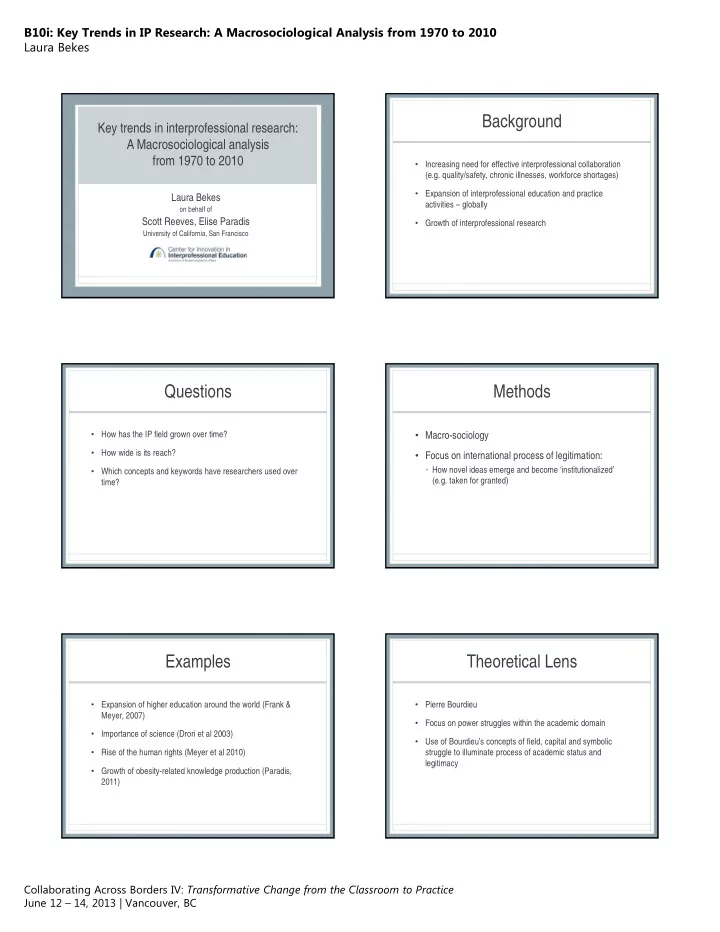

B10i: Key Trends in IP Research: A Macrosociological Analysis from 1970 to 2010 Laura Bekes Background Key trends in interprofessional research: A Macrosociological analysis from 1970 to 2010 • Increasing need for effective interprofessional collaboration (e.g. quality/safety, chronic illnesses, workforce shortages) • Expansion of interprofessional education and practice Laura Bekes activities – globally on behalf of Scott Reeves, Elise Paradis • Growth of interprofessional research University of California, San Francisco Questions Methods • How has the IP field grown over time? • Macro-sociology • How wide is its reach? • Focus on international process of legitimation: • How novel ideas emerge and become ‘institutionalized’ • Which concepts and keywords have researchers used over (e.g. taken for granted) time? Examples Theoretical Lens • Expansion of higher education around the world (Frank & • Pierre Bourdieu Meyer, 2007) • Focus on power struggles within the academic domain • Importance of science (Drori et al 2003) • Use of Bourdieu’s concepts of field, capital and symbolic • Rise of the human rights (Meyer et al 2010) struggle to illuminate process of academic status and legitimacy • Growth of obesity-related knowledge production (Paradis, 2011) Collaborating Across Borders IV: Transformative Change from the Classroom to Practice June 12 – 14, 2013 | Vancouver, BC
B10i: Key Trends in IP Research: A Macrosociological Analysis from 1970 to 2010 Laura Bekes Focus Data Collection 1. Investigate the growth of interprofessional research and • PubMed search of interprofessional-related articles discuss its representation in various publications • 1970-2010 time period 2. Document the evolution of language use in the • Key terms – interprofessional*, inter-professional*, multi- interprofessional literature. professional*, multiprofessional*, multidisciplinar*, multi- 3. Explore how interprofessional research as a field trying to disciplinar*, interdisciplinar* establish academic legitimacy • Yield: 100,488 articles, from 1970-2010 Analysis Findings Fig. 1: IP Articles in and as a Percent of PubMed, 1970 ‐ 2010 • 436 keywords were identified using key texts in the IP literature; Number of Articles Articles as %PubMed 10,000 100% 202 countries covered 9,000 90% 8,000 80% • Data were input into a Python-language computer program that Articles as a % of PubMed 7,000 70% coded the titles of all 100,488 articles into a binary matrix No. of Articles 6,000 60% (0=keyword not present; 1=keyword present) 5,000 50% • Data were aggregated and mapped over time using SPSS 17 4,000 40% 3,000 30% 2,000 20% 1,000 10% 0 0% 1970 1975 1980 1985 1990 1995 2000 2005 2010 Fig. 2: Number of Journals that Published IP Research, 1970 ‐ 2010 Fig. 3: Internationalization of IP Research, 1970 ‐ 2010 2,500 Countries other than US United States (US) No. of Countries 30 90 80 2,000 25 70 20 60 1,500 No. of Journals No. of Countries % of Sample 50 15 40 1,000 10 30 20 500 5 10 0 0 1970 1975 1980 1985 1990 1995 2000 2005 2010 0 1970 1975 1980 1985 1990 1995 2000 2005 2010 Collaborating Across Borders IV: Transformative Change from the Classroom to Practice June 12 – 14, 2013 | Vancouver, BC
B10i: Key Trends in IP Research: A Macrosociological Analysis from 1970 to 2010 Laura Bekes Fig. 4: Interprofessional Key Terms in IP Research, 1970 ‐ 2010 Fig. 5: Managerial Rhetoric in IP Publications, 1970 ‐ 2010 Interdisciplinar Interprofessional Multidisciplinar Manage/managing Improve/improving Outcome 10 9 9 8 8 7 7 6 6 % of Sample % of Sample 5 5 4 4 3 3 2 2 1 1 0 1970 1975 1980 1985 1990 1995 2000 2005 2010 0 1970 1975 1980 1985 1990 1995 2000 2005 2010 Fig. 7: Individual Actors in IP Publications, 1970 ‐ 2010 Fig. 6: Psychometric Approaches in IP Research, 1970 ‐ 2010 Nurse Staff Student Physician/doctor/GP Group Processes Assess Evaluate/evaluation Outcome 25 3.5 3 20 2.5 15 % of Sample % of Sample 2 1.5 10 1 5 0.5 0 1970 1975 1980 1985 1990 1995 2000 2005 2010 0 1970 1975 1980 1985 1990 1995 2000 2005 2010 Fig. 8: Emerging Directions in IP Publications, 1970 ‐ 2010 Fig. 9: Trends in IP Scholarship, 1970 ‐ 2010 Care/caring Patient Health 14 Review Qualitative Quantitative Mixed Methods 3 12 2.5 10 2 % of Sample 8 1.5 6 1 4 0.5 2 0 1970 1975 1980 1985 1990 1995 2000 2005 2010 0 1970 1975 1980 1985 1990 1995 2000 2005 2010 Collaborating Across Borders IV: Transformative Change from the Classroom to Practice June 12 – 14, 2013 | Vancouver, BC
B10i: Key Trends in IP Research: A Macrosociological Analysis from 1970 to 2010 Laura Bekes Discussion • Continuous growth of interprofessional – research • Bourdieu’s framework – interprofessional research publications process of legitimization: • ‘Interprofessional’ more common since 2000 o High impact journals • Rise of management rhetoric & psychometrics: focus o International reach mirrors broader trends • Symbolic struggle: • Decline in individual professions o Terminological issues – ‘interprofessional’, • Rise in the use of the terms ‘care/caring’ and ‘patient’ – ‘interdisciplinary’, ‘multidisciplinary’ patient advocacy, user involvement and patient-centered care o Psychometric paradigm – metrics and assessment Questions? Paradis E & Reeves S (forthcoming) Key trends in interprofessional research: a macrosociological analysis from 1970 to 2010. J Interprof Care. DOI: 10.3109/13561820.2012.719943 http://informahealthcare.com/toc/jic/0/0 Scott.Reeves@ucsf.edu Elise.Paradis@ucsf.edu Collaborating Across Borders IV: Transformative Change from the Classroom to Practice June 12 – 14, 2013 | Vancouver, BC
Recommend
More recommend